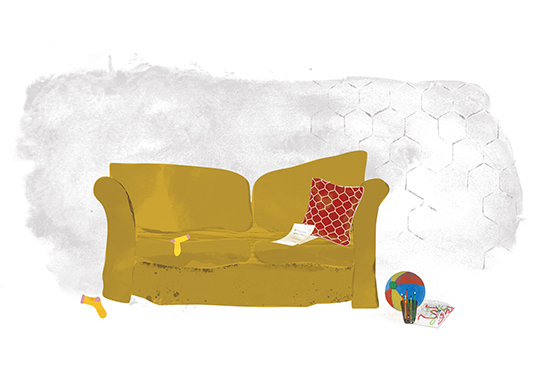Ten stories underscored by 360-meter galleries; 1600 windows on the street side, and another 1600 windows in which the sun was reflected each day across Amsterdam Zuidoost. And between them were the people. Some wore their lives like tight-fitting jackets, awkwardly and too self-consciously. For others, life was more like a baggy overcoat hanging off their shoulders, they didn’t know how to fill all that expectant space.
Royal was the idea. For this reason, the building, along with other blocks of flats, formed a grid-like pattern. One that, if you were to look down at it from high above, would resemble a honeycomb. Honey, from bees; bees who work to serve their queen.
But royal it wasn’t. Kings, everyone knows, live in houses made of marble and have little to do with concrete. If you stripped these flats of their wallpaper, their people, their cheap laminate flooring, and the white tiles in the sober little kitchens, only concrete would remain. But while there was no trace of marble or gold, the block of flats was still a precious thing. It pulsed with life; a satisfied, grieving, excited, aroused, sleepy buzz between the concrete floors and ceilings, between the 1600 windows that overlooked the street and the other 1600 windows through which the sun peeked as it busied itself, cloaking the park in shadows.
The building began ageing almost as soon as it was completed. Moss and rust took hold, spray cans and indelible pens left their mark. But it kept on standing, supporting the people who climbed it, pissed on it, even scoffed at it. And at least as many people who loved it because of its panoramic views, and because it contained their homes. So, in spite of the piss, the moss, and the daubed expletives, it remained standing. Indefatigable, because it was the rock-solid foundation of all these lives combined.
Take the flat on the ninth floor. Behind the front door with the horsehair doormat and out-of-date children’s charity sticker next to the bell, lived a young woman with her two children, back when a tricycle was chained to the drainpipe. She was stubborn and noisy. She could have stared down the devil. The flat supported a couch the mother collapsed onto every time she grew tired of the things that make women tired: men, children, bosses, their own mothers—in this case also bill collectors, social workers; all equally convinced of their own rectitude. Mind, she was also very sure of herself, so they had their work cut out for them. She and her two light-brown kids who took turns tearing up and down the gallery on the tricycle, who she loved more than life itself. She was foul-mouthed but she loved this block of flats. And the block of flats loved her back, because when it stormed outside, the wind whipped around the ninth floor of the building with terrific force. It whistled and moaned and forced itself through the cracks to drown out every thought, every dream the woman could possibly dream in that moment. The children were used to the sounds; they were born inside—during one of those stormy nights, perhaps. They slept through it all, unperturbed. But the mother did not sleep. She crept down deep under her blanket and imagined she could feel the flat sway gently with the strength of the wind. But it stood stronger than ever; feet planted firmly in the ground, proud shoulders, head in the wind. She didn’t need to be afraid. It had been built for this. It was loyal.
Still, she'd had to leave. Probably because of the storms, and the elevation. Because, in spite of the elevation, there were always people above her. People who walked around and argued and dropped things, which made her stiffen with anxiety as she sat on the couch. In these moments, the world felt too close. Then, when she looked out the window, into the distance, the other blocks of flats partially visible, and below, the park with its footpaths and its trees and the tiny figures moving through it—it felt too far away. She couldn’t get used to it, so she left. Taking her kids, the tricycle, and everything else, until all that remained was the parquet floor, the white chipboard cabinets in the simple kitchen, and the children’s charity sticker next to the bell.
Before long an old woman moved in. She turned the kids’ room into a guest room for her adult son on the off chance he would ever come to sleep in it. Unlike the young woman, she didn’t put the couch against the back wall, placing it instead along the short side of the room. She added a wooden rocking chair with a high back beside the window, a TV, a radio, a dark wooden dining table with a crocheted tablecloth. On the first afternoon that the wind picked up again, the flat stood firm. Reinforced feet planted firmly in the ground, head in the wind. The old woman sank into her chair and looked outside, just as she would every day in the late afternoon, when the sun sank behind the buildings in the distance, with the park below and the shadows of the trees growing longer. She poured herself another glass of jenever, satisfied yet a little sad, because of the sinking sun, and the shadows—they make you feel things. The wind pounded fiercely against the windows, forcing itself through the cracks. The old woman took tiny sips of her drink. And the flat faced the wind. Because concrete is loyal.

